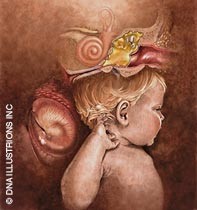Peer Reviewed
Feature Article Ear, nose and throat medicine
Tympanic membrane changes after Eustachian tube obstruction in children: early recognition helps avoid irreversible damage
Abstract
Structural damage to the tympanic membrane as a consequence of Eustachian tube blockage occurs more easily in young children than in older children and adults. It can ultimately result in the formation of a cholesteatoma, for which surgical intervention will be required.
Key Points
- Recognising the visible early changes in the tympanic membrane that follow Eustachian tube obstruction may allow their progression to be arrested.
- When the Eustachian tube is obstructed, the middle ear pressure becomes negative, the tympanic membrane retracts and thins, the handle of the malleus rotates and the membrane may contact bony structures.
- If left untreated, the action of the ossicular chain becomes impaired as the bones are eroded or unable to move due to adhesions.
- Acquired cholesteatomas may develop from retraction pockets that form in the tympanic membrane.
- Family doctors should maintain a high index of suspicion for cholesteatoma and refer early if it is suspected.
Purchase the PDF version of this article
Already a subscriber? Login here.

